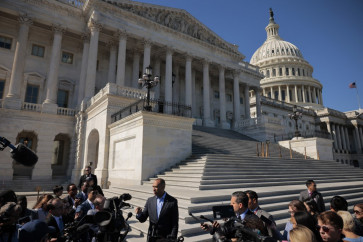Popular Reads
Top Results
Can't find what you're looking for?
View all search resultsPopular Reads
Top Results
Can't find what you're looking for?
View all search resultsDollar gains as traders trim US rate cut bets
Change text size
Gift Premium Articles
to Anyone
T
he dollar headed for its largest weekly rise in a month and a half on Friday as surprisingly strong US economic data has left markets on edge about the outlook for US inflation and interest rates.
May figures showed US business activity accelerated to the highest level in just over two years and manufacturers reported surging input prices, prompting a pullback in US interest rate cut expectations and a rise in government bond yields.
The dollar is up almost 1 percent this week on the Japanese yen to 157.11 yen, even though Japanese government bond yields have climbed too, scaling decade highs and clearing 1 percent at the ten-year tenor.
Japan's core inflation slowed for a second straight month in April, meeting market expectations - and staying above the central bank's target - at 2.2 percent.
"It's having very little effect on the yen," said Martin Whetton, head of financial markets strategy at Westpac in Sydney. "The carry of holding dollars is far juicier," he said, while policymakers' rhetoric has also made traders nervous about inflation and the risk rate cuts will be distant or small.
Minutes from the Federal Reserve's last meeting published this week showed a live debate among policymakers as to whether current rates are sufficiently restrictive to cool inflation.
Traders have pushed out the timing of the first Fed rate cut to December.
The Australian dollar faded to $0.6592 on Friday, having failed to hold a key $0.6650 chart level. That left it down 1.4 percent for the week and well away from the recent four-month top of $0.6714.
The New Zealand dollar has been underpinned by a hawkish shift in outlook from the Reserve Bank of New Zealand but remains 0.6 percent weaker on the week at $0.6098.
The euro was helped off a nine-month low on the pound EURR on Thursday when a key European wage indicator picked up.
However, the moves were modest and the European Central Bank published a blog post highlighting one-off factors contributing to the wage rise. Rates markets still price a near 90 percent chance the ECB cuts rates next month.
The euro traded at $1.0809 in Asia, down 0.5 percent for the week.
China started a second day of war games around Taiwan. China's yuan was steady on Friday at 7.2454 per dollar, eying its steepest one-week fall since March.
The US dollar index, which measures the dollar against a basket of six major peers, was last up nearly 0.6 percent on the week to 105.1, on course for its largest one-week rise since mid-April.
Later in the day traders will have an eye on final German GDP figures, British and Canadian retail sales, US durable goods orders and speeches from ECB and Federal Reserve policymakers - notably Fed Governor Christopher Waller on longer-term rates.











